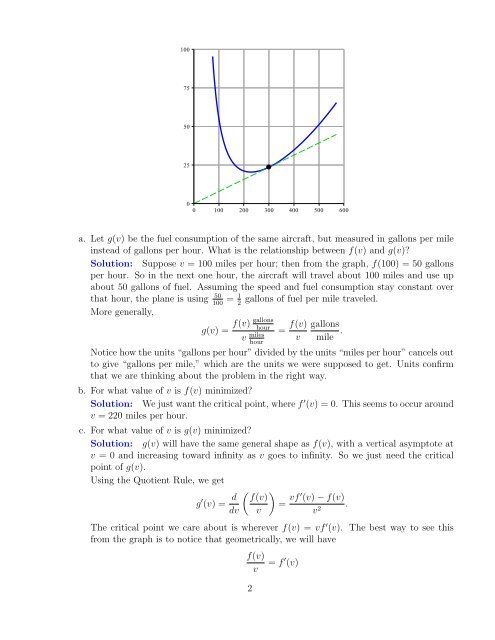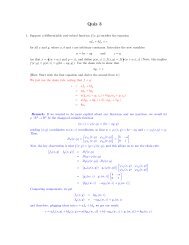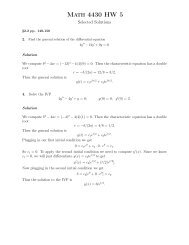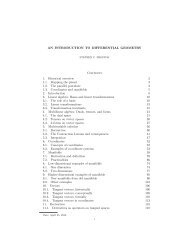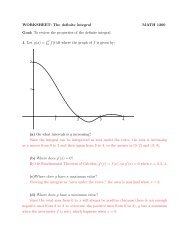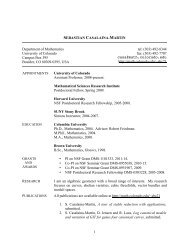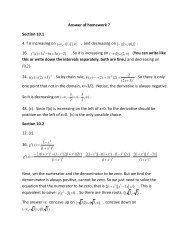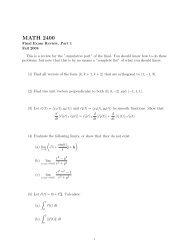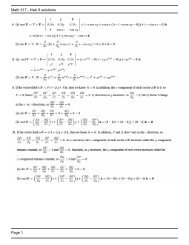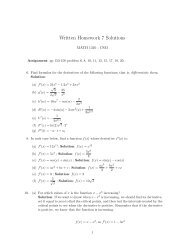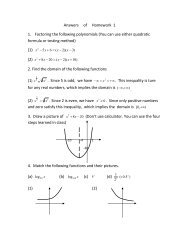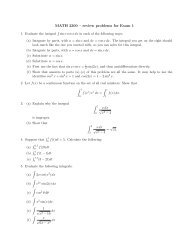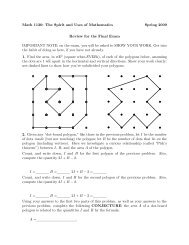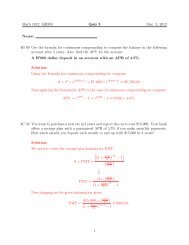Math 1300 Written Homework #10 Solutions 4.2, Q. 24. Let y = at 2e ...
Math 1300 Written Homework #10 Solutions 4.2, Q. 24. Let y = at 2e ...
Math 1300 Written Homework #10 Solutions 4.2, Q. 24. Let y = at 2e ...
You also want an ePaper? Increase the reach of your titles
YUMPU automatically turns print PDFs into web optimized ePapers that Google loves.
a. <strong>Let</strong> g(v) be the fuel consumption of the same aircraft, but measured in gallons per mile<br />
instead of gallons per hour. Wh<strong>at</strong> is the rel<strong>at</strong>ionship between f(v) and g(v)?<br />
Solution: Suppose v = 100 miles per hour; then from the graph, f(100) = 50 gallons<br />
per hour. So in the next one hour, the aircraft will travel about 100 miles and use up<br />
about 50 gallons of fuel. Assuming the speed and fuel consumption stay constant over<br />
th<strong>at</strong> hour, the plane is using 50 1 = gallons of fuel per mile traveled.<br />
100 2<br />
More generally,<br />
g(v) = = f(v) gallons<br />
v mile .<br />
f(v) gallons<br />
hour<br />
v miles<br />
hour<br />
Notice how the units “gallons per hour” divided by the units “miles per hour” cancels out<br />
to give “gallons per mile,” which are the units we were supposed to get. Units confirm<br />
th<strong>at</strong> we are thinking about the problem in the right way.<br />
b. For wh<strong>at</strong> value of v is f(v) minimized?<br />
Solution: We just want the critical point, where f ′ (v) = 0. This seems to occur around<br />
v = 220 miles per hour.<br />
c. For wh<strong>at</strong> value of v is g(v) minimized?<br />
Solution: g(v) will have the same general shape as f(v), with a vertical asymptote <strong>at</strong><br />
v = 0 and increasing toward infinity as v goes to infinity. So we just need the critical<br />
point of g(v).<br />
Using the Quotient Rule, we get<br />
g ′ (v) = d<br />
dv<br />
<br />
f(v)<br />
v<br />
= vf ′ (v) − f(v)<br />
v2 .<br />
The critical point we care about is wherever f(v) = vf ′ (v). The best way to see this<br />
from the graph is to notice th<strong>at</strong> geometrically, we will have<br />
f(v)<br />
v = f ′ (v)<br />
2


